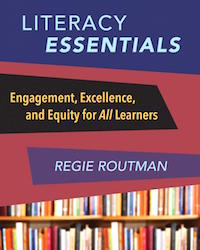Engage All Learners in the Essentials of Literacy
Literacy Essentials: Engagement, Excellence, and Equity for All Learners
By Regie Routman
(Stenhouse Publishers, 2018 – Learn more)
 Reviewed by Pam Hamilton
Reviewed by Pam Hamilton
Regie Routman has been a trusted name in literacy education for many decades. She has been an author, teacher, coach and mentor to administrators and teachers for forty-five years. She is the author of many well-known “teacher textbooks,” including Conversations: Strategies for Teaching, Learning and Evaluating; Reading Essentials; Writing Essentials; Teaching Essentials; Transitions from Literature to Literacy; and Literacy at The Crossroads, just to name a few.
 Literacy Essentials: Engagement, Excellence, and Equity for All Learners grew out of an earlier work, Literacy and Learning Lessons from a Longtime Teacher (2012). This major work provides a deeper, fuller view of literacy and learning. Also included are additional online resources, such as the book’s study guide, appendices, and extensive references and resources that support the text and provide additional professional reading.
Literacy Essentials: Engagement, Excellence, and Equity for All Learners grew out of an earlier work, Literacy and Learning Lessons from a Longtime Teacher (2012). This major work provides a deeper, fuller view of literacy and learning. Also included are additional online resources, such as the book’s study guide, appendices, and extensive references and resources that support the text and provide additional professional reading.
A long book easily accessed
In the introduction Routman says: “This is a long book. Knowing how busy and complicated life can be, I struggled with that length. However, at the same time I wanted to provide the tools, information, and inspiration you need to make your teaching and learning lives more authentic and vigorous.”
You’ll find that this is a long review. I also struggled. However, as I considered how I might shorten my discussion of this book, I worried that I might leave out something that could be the deciding factor for you to read it! And you really must read this book!
Even though it’s over 400 pages, Literacy Essentials is organized so that the reader can settle in for deep, page-by-page reading, or skim and scan in and out of the many issues presented. Although the author recommends that the reader start at the beginning, it is possible to begin anywhere, using the table of contents to guide you to your present concerns.
Across the book’s three sections, there is a common connecting thread—all three focus on a thriving school culture where every learner can succeed and feel empowered. “Much of this book is devoted to showing how teacher practice, school culture, and school change are interconnected.” According to Routman, “How and why we must do better for all students is the overriding theme of this book and, I believe, the core civil rights issue of our time.”
Included in the appendices is a very helpful self-evaluation for determining your school’s culture. It would be beneficial to use to have teachers evaluate their team culture as well as the whole school culture.
Building engagement
The first thing discussed in the section “Engagement” is Developing Trusting Relationships. The author notes the impact that positive relationships have on the health, well-being and achievement of all school community members. These trusting relationships include relationships among administration, school board, community, teachers, staff, parents, and students. Routman states that, “I have never seen a school increase and sustain literacy achievement without a schoolwide culture of trust and respect.”
Each section also includes “Take Action” sections with suggestions for how to make changes right now in your school/classroom. There are also various stories sprinkled throughout the pages that add a nice touch and expand on the ideas presented.
The value of celebrating learners
The first section also addresses the importance of Celebrating Learners. The author refers to celebration as the “heart and soul” of our best teaching. Whenever we celebrate something a learner has done well, we affirm that behavior, skill, strategy, or effort and, consequently, increase the likelihood that the student will do it again.
However, in order to be effective, celebration must be specific. We can’t simply offer casual words of praise without telling students exactly what it is that they’re doing well—EVERYTHING the learner has done well.
I believe it’s important to note, as Routman says, “Teachers are more likely to celebrate their students’ strengths if principals celebrate their teachers.” This goes back to that common thread throughout the book of a schoolwide culture of trust and respect.
Also in this section, the author reminds us that being able to celebrate and move students forward in their learning requires teachers to maintain ongoing, high-level professional learning, so they are prepared to recognize and appreciate those skills and strategies that will most benefit the learner.
The final parts of “Engagement” deal with Creating a Thriving Environment and Teaching with Purpose and Authenticity.
Achieving excellence
The second section of the book is titled “Excellence.” The subtitles are Embedding Professional Learning; Expert Teaching Through Frontloading; Listening, Speaking, and Questioning; Embracing the Reading-Writing Connection; Teaching Readers; and Teaching Writers.
The first part of this section is based on the premise that we must have a commitment to professional learning. However, Routman states that often this takes a top-down approach which is not as effective as professional learning that comes from within the school and district—looking among ourselves for “experts” instead of looking for that “right” program or expert to “fix” things.
This section also talks about frontloading, which is preparing students adequately before releasing them to try on their own. This makes it much more likely that they will succeed.
In the second section, there are self-checks for teachers to evaluate the types of questions they ask, as well as a student evaluation of teaching and learning.
Sections 4 and 5 discuss the important connections between reading and writing, and the importance of daily read alouds and independent reading. Section 5, Teaching Readers, also has guidelines for how to conduct a reading conference.
Embedding equity
The final section, “Equity,” tackles the issues of Making High Expectations an Instructional Reality; Reaching All Learners; Applying Responsible Assessment; Developing Self-determining Learners; and Advocating for Students.
Routman describes this section as giving “perspectives on realities, possibilities, and solutions for ensuring more equitable opportunities for learning for all students.” She starts this section making it clear that equity and equality are not the same. There’s a quote from Pedro Noguera: “Giving everyone a shoe is equality; making sure the shoe fits is equity.”
In my 24 years in education, I’ve heard people talk about “fairness” and “equality,” but what Routman points out is that “educational equity means that each child receives what he or she needs to develop to his or her full academic and social potential.” She also fully realizes that this is not an easy task!
Section 1 includes a self-check to look at your curriculum and see if you’re maintaining high expectations for students. She also addresses issues with standards and how to cope with implementing standards into our teaching. This section also describes whole-part-whole teaching.
Section 2 takes a look at ensuring excellent instruction from the start and thereby reducing the need for intervention. Routman also addresses meeting the needs of English Language Learners and promoting oral language development.
The rest of “Equity” deals with assessment, teaching students to be self determined, and advocating for students.
I’ve only begun to describe what’s in this book. You can take a look at the complete text here. As always, Regie Routman has delivered a thoughtful, thought-provoking resource that will not fail to inspire you in your professional journey.
Pam Hamilton is in her 24th year as an educator and her 5th year as an Intermediate Literacy Coach for Middlebury Community Schools. She loves being able to support teachers in their literacy teaching and learning! Most important, she is wife to Steve and mama to two beautiful daughters, Allie and Peyton.


































